81 Road Code Questions of 02 Key Driving Skills
Note: If you wish to check whether you have master these questions, you may
proceed to
Take a Practice Test now with only questions from this Road Code topic.
If you do not have an account yet,
Sign Up one now, it is
FREE!
# 1. When coming up to a Stop sign, where should you stop?
A. With the front wheels of your vehicle on the yellow lines.B. With the rear wheels of your vehicle on the yellow lines.C. Where you can see all vehicles coming from all directions.D. Where you can only see vehicles coming from your right.
Explanation : At an intersection controlled by a Stop sign you must: come to a complete stop, not just slow down. stop where you can see vehicles coming from all directions
# 2. What colour are the 2 lines painted on a sealed road at a Give Way sign?
A. Yellow.B. White.C. Grey.D. Red.
Explanation : Double or single white lines are marked on sealed roads to help you stop where you can best see other traffic.
# 3. When may you use the horn on your vehicle?
A. As a reasonable traffic warningB. To make people get out of your wayC. To annoy other traffic usersD. During a police chase
Explanation : horn is used to warn road users of possible danger
# 4. The bonnet of your vehicle lifts up while you are driving and you cannot see. What should you do?
A. Turn your vehicle headlights on and look out of the side window.B. Brake smoothly and move over to the left side of the road.C. Steer your vehicle straight ahead and stop as quickly as you can.D. Speed up and move to the left side of the road.
Explanation : If the bonnet flies up while you are driving you should: steer by looking through the gap under the hinge of the bonnet or out the side window; brake smoothly, indicate and move over to the left-hand side of the road.
# 5. When turning right at a roundabout, you must:
A. not indicate at any time on the roundabout.B. indicate left before entering the roundabout.C. indicate right before entering the roundabout.D. indicate right when leaving the roundabout.
Explanation : If you are travelling more than halfway around a roundabout: signal right as you come up to the roundabout; and signal left as you pass the exit before the one you wish to take.
# 6. When should one dip the car headlight?
A. driving in daylightB. when there is no vehicle in front and weather is goodC. when you are driving in a funeral processionD. after a heavy rain and driving in motorway
Explanation : If you are driving in a funeral procession, you should drive with your vehicle's headlights on dip. That way, other drivers will know you are part of the procession.
# 7. After driving through surface water, you should:
A. stop and wait for your vehicle to dry out.B. not brake for the next 500 metres.C. brake heavily 2 or 3 times.D. pump your vehicle brakes gently.
Explanation : After driving through surface water, pump the brakes several times to dry them out. This works for both ordinary and anti-lock system (ABS) brakes.
# 8. When should you use the hazard lights on your vehicle?
A. When you are changing a tyre on the side of the road.B. When you are coming up to an airport.C. When you are double-parked.D. When you are in a hurry.
Explanation : You should only turn on your hazard lights when your vehicle becomes a temporary hazard to other road users, such as when: you're changing a tyre on the side of the road. your vehicle has broken down and is being towed.
# 9. How should you dry out the brake after driving through surface water?
A. Swerve carefully from side to side to dry out the brakes on your vehicle.B. Move to the left of the road and dry out the wheels of your vehicle.C. Drive with your vehicle handbrake on for at least 5 minutes.D. Pump your vehicle brakes carefully several times to dry them out.
Explanation : After driving through surface water, pump the brakes several times to dry them out. This works for both ordinary and anti-lock system (ABS) brakes.
# 10. To help you from being blinded by the headlights of an oncoming vehicle, you should:
A. look to the left-hand side of the road.B. look to the right-hand side of the road.C. look to the centre of the road.D. turn the headlights of your vehicle onto high beam.
Explanation : if you are blinded by the lights of oncoming vehicles: slow down or stop
; or try to keep your eyes on the left side of the road, so you aren't looking directly at the light
# 11. At night, you MUST always dip the headlights on your vehicle when:
A. driving around town.B. driving on a motorway.C. following other vehicles.D. driving in the country.
Explanation : You must dip your vehicle's headlights: when other vehicles are coming towards you. or when you are following other vehicles, or when a police officer is directing traffic, or when you park.
# 12. What should you do when another vehicle is following you very closely?
A. Speed up to get further ahead.B. Brake suddenly to warn them.C. Flick your vehicle lights and wave your arm.D. Slow down, move to the left and allow the vehicle to pass.
Explanation : If a vehicle is following you too closely, slow down, move over and let it pass as soon as you can do so safely.
# 13. This sign tells you that you are coming up to a railway level crossing. What should you do?
 A. Slow down so that you can look both ways to check that the crossing is clear.B. Speed up to drive over the crossing as quickly as possible.C. Stop to check whether the crossing is clear.D. Turn your vehicle indicators on before driving over the crossing.
A. Slow down so that you can look both ways to check that the crossing is clear.B. Speed up to drive over the crossing as quickly as possible.C. Stop to check whether the crossing is clear.D. Turn your vehicle indicators on before driving over the crossing.
Explanation : When you see a railway level crossing signs: slow down and be ready to stop; cross only if you are sure there are no trains coming in either direction and there are no vehicles stopped in front of you on the other side of the crossing.
# 14. When turning left into a driveway, slow down and:
A. check the driveway is clear and enter.B. signal only if there is a vehicle behind you and enter.C. signal for 3 seconds or more and if the driveway is clear, enter.D. signal only if another vehicle is coming towards you and enter.
Explanation : If you are turning left into driveway: stay in the left lane or keep to the left side of the road; and slow down before you turn; check your rear-view mirror and your blind spot; and signal for at least three seconds; turn when safe.
# 15. If yellow traffic signals are flashing it means:
A. that a crash has just happened.B. the traffic signals are not working, apply the give way rules.C. vehicles may only proceed straight ahead and not turn.D. emergency vehicles are about to come through.
Explanation : A flashing yellow signal means the traffic signals are not working. In this case you must apply the give way rules for uncontrolled intersections.
# 16. What must you do when you see 2 red lights flashing outside a fire station?
 A. Slow down and drive on carefully if the way is clear .B. Slow down and stop if any other vehicle is comingC. Slow down to 20 km/h.D. Stop until the lights stop flashing.
A. Slow down and drive on carefully if the way is clear .B. Slow down and stop if any other vehicle is comingC. Slow down to 20 km/h.D. Stop until the lights stop flashing.
Explanation : Red flashing signals outside a fire station or airport mean you must stop and remain stopped until the lights stop flashing.
# 17. To help you from being blinded by the headlights of an oncoming vehicle, you should:
A. turn the headlights of your vehicle off for a short time.B. turn the headlights of your vehicle onto high beam.C. slow down and if you cannot see, stop.D. watch the headlights of the oncoming vehicle to help you see where you are on the road.
Explanation : if you are blinded by the lights of oncoming vehicles: slow down or stop
; try to keep your eyes on the left side of the road, so you aren't looking directly at the light
# 18. You must signal that you are turning to the right:
A. as you are turning.B. only if there are vehicles in front of you.C. 3 seconds or more before you turn.D. only if there are vehicles following behind you.
Explanation : You must signal for at least three seconds before you: turn left or right
# 19. which of your vehicle lights do you have on when driving in fog?
A. Hazzard LightsB. Headlights on High BeamC. Headlights on dipD. tail lights
Explanation : When travelling in fog, rain or snow, drive with your lights
dipped for increased safety.
# 20. What does this traffic signal mean?
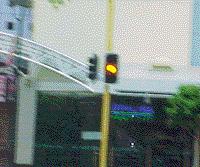 A. Drive on before the signal changes to red.B. Drive on because the signal will turn green.C. Stop if you can do so safely.D. Stop only if traffic is in the way.
A. Drive on before the signal changes to red.B. Drive on because the signal will turn green.C. Stop if you can do so safely.D. Stop only if traffic is in the way.
Explanation : A yellow signal means stop, unless you are so close to the intersection that you can't stop safely.
A yellow signal indicates that the lights will soon turn red.
# 21. What must you do when you see blue and red flashing lights behind you?
A. Speed up to get out of the way.B. Slow down and drive on carefully.C. Slow down and stop.D. Drive on as usual.
Explanation : If a police car is following you with its siren on and/or flashing blue, or blue and red lights, you must pull over and stop as soon as possible.
# 22. You must not move on to a railway level crossing until:
A. you are going fast enough so that you do not stop on the crossing.B. you see that the lines are clear both ways and there are no vehicles stopped in front of you.C. you have the headlights of your vehicle turned onto high beam.D. you sound the horn on your vehicle.
Explanation : cross only if you are sure there are no trains coming in either direction and there are no vehicles stopped in front of you on the other side of the crossing.
# 23. When driving at night, which vehicle lights should you turn on?
A. Headlights.B. Park lightsC. Interior lights.D. Hazard lights.
Explanation : You must turn on your vehicle's headlights: from 30 minutes after sunset, until 30 minutes before sunrise; at any other time when you can't clearly see a person or vehicle 100 metres away.
# 24. What does this road marking mean?
 A. Taxi stand.B. Fire hydrant.C. Railway level crossing ahead.D. Pedestrian crossing ahead.
A. Taxi stand.B. Fire hydrant.C. Railway level crossing ahead.D. Pedestrian crossing ahead.
Explanation : Fire hydrant road marking
# 25. This signal means - I am going to:
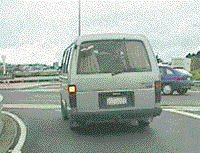 A. slow down.B. turn left.C. move towards the right.D. stop.
A. slow down.B. turn left.C. move towards the right.D. stop.
Explanation : Signalling left
# 26. which side of the road should you keep to at all times except for emergency?
A. leftB. rightC. left and rightD. centre
Explanation : always keep left, it is one of the most important road and safety rules
# 27. You must pull over and allow an ambulance or fire engine to pass:
A. at all times.B. at an uncontrolled intersection.C. when it is operating its siren or flashing lights.D. when it is turning right and you have the right of way.
Explanation : If an emergency vehicle (such as an ambulance, fire engine or police car) is coming towards you or behind you, and is using sirens and/or flashing red, blue, or blue and red lights, you must pull over and, if necessary, stop and allow it to pass.
# 28. What are the three main types of road surfaces on our New Zealand roads?
A. tar, country-road and rockB. asphalt, chip-seal and gravelC. limestone, fine-sand and mudD. concrete, brick-gravel and clay
Explanation : There are three main types of surface used on New Zealands roads and highways: asphalt, chip-seal, gravel.
# 29. A vehicle can use the flush median strip:
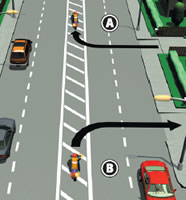 A. to move into the traffic flow.B. to park for 5 minutes only.C. as a driving lane.D. to unload goods or passengers.
A. to move into the traffic flow.B. to park for 5 minutes only.C. as a driving lane.D. to unload goods or passengers.
Explanation : A flush median is a strip in the centre of the road that is marked with white diagonal lines within parallel lines. It provides a place for vehicles that are turning right, or vehicles that have turned right onto the road from a side road or driveway.
# 30. If you are driving in fog, your vehicle should have its:
A. park lights on.B. headlights on dip.C. headlights on high beam.D. hazard lights on.
Explanation : Dip your lights. illegal to drive with just park lights on in fog. the front fog lights have a wide, low beam and produce either a white or yellow light. Rear fog lights produce a high-intensity red light, should only be used when visibility is very bad.
# 31. In addition to checking it is safe to move out from the kerb into the traffic flow, what must you do?
A. Accelerate quickly into the traffic flow.B. Move slowly into a space in the traffic flow.C. Signal for at least 3 seconds.D. Reverse away from the kerb.
Explanation : You must signal for at least three seconds before you move out: from a parking space; to pass another vehicle; to change lanes.
# 32. What must you do when you come up to a red light showing at traffic signals?
A. Stop and then go on carefully.B. Go on slowly if no other traffic is coming.C. Stop only if other vehicles are coming from the right.D. Stop and wait until it changes to a green light.
Explanation : A red signal means stop.
# 33. For a trailer/towed vehicle what lights should it have on at night?
A. its break lightsB. its head lightsC. its tail lightsD. its hazard lights
Explanation : At night the back of the trailer/towed vechicle must show a red light (its tail lights)
If you are towing a disabled vehicle at night, its headlights must light up the towing connection.
# 34. After driving through surface water, you should:
A. pump your vehicle brakes carefully.B. not use the brakes on your vehicle.C. brake heavily.D. check that the headlights on your vehicle are working.
Explanation : After driving through surface water, pump the brakes several times to dry them out. This works for both ordinary and anti-lock system (ABS) brakes.
# 35. what does the blue light on the road mean?
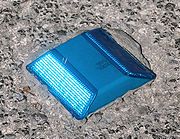 A. tunnel under the roadB. fire hydrant on the sideC. police station up aheadD. lane mark to guide traffic at night
A. tunnel under the roadB. fire hydrant on the sideC. police station up aheadD. lane mark to guide traffic at night
Explanation : fire hydrant on the side of the road
# 36. if you see flashing red and blue lights behind you should you
A. continue drivingB. speed upC. pull overD. slow down
Explanation : If a police car is following you with its siren on and/or flashing blue, or blue and red lights, you must pull over and stop as soon as possible.
# 37. Which one of the following lights should your vehicle use when driving in fog?
A. Park lights.B. Headlights on high beam.C. Hazard lights.D. Dipped headlights.
Explanation : Dip your headlamps in fog. If you drive with your lamps on full beam in fog, the light will just reflect back on you. Dip your lights, it will be much easier to see.
# 38. You MUST dip the headlights on your vehicle when:
A. coming up to an intersection.B. driving in city shopping areas.C. driving on a winding road.D. you are following other vehicles.
Explanation : You must dip your vehicle's headlights: when other vehicles are coming towards you, so that you don't blind the oncoming driver; or when you are following other vehicles; or when a police officer is directing traffic; or when you park.
# 39. Can you stop on a bus stop in a private motor vehicle?
A. Only between midnight and 6 am.B. Under no circumstances.C. When dropping off passengers.D. Only if it is for less than 5 minutes.
Explanation : You may not stop there at any time. Only buses can stop here
# 40. What should you do if an ambulance comes up behind you, flashing red lights or sounding its siren?
A. Speed up to avoid delay.B. Put your vehicle hazard lights on and drive on at the same speed.C. Slow down, pull over and allow the ambulance to pass.D. Flash your vehicle headlights to warn oncoming traffic.
Explanation : If an emergency vehicle (such as an ambulance, fire engine or police car) is coming towards you or behind you, and is using sirens and/or flashing red, blue, or blue and red lights, you must pull over and, if necessary, stop and allow it to pass.
# 41. You must turn your vehicle headlights on:
A. 15 minutes after sunset until 15 minutes before sunrise.B. 30 minutes after sunset until 30 minutes before sunrise.C. 45 minutes after sunset until 45 minutes before sunrise.D. 1 hour after sunset until 1 hour before sunrise.
Explanation : ou must turn on your vehicle's headlights: from 30 minutes after sunset, until 30 minutes before sunrise; at any other time when you can't clearly see a person or vehicle 100 metres away. Never drive with just the park lights on during these times.
# 42. What should you do when another vehicle is following very closely?
A. Speed up and get further aheadB. Brake suddenly to warn themC. Flick your vehicle lights and wave you armD. Slow down, move to the left and allow the vehicle to pass.
Explanation : If a vehicle directly behind you is following very closely, carefully slow down and allow the vehicle to pass by.
# 43. where to position your vehicle when driving on a two-way road?
A. on the leftB. on the rightC. in the middleD. where ever you want
Explanation : keep left when driving on the road
# 44. What does this marking mean?
 A. 5 hours.B. Fire hydrant.C. Fire hose.D. Fire hazard.
A. 5 hours.B. Fire hydrant.C. Fire hose.D. Fire hazard.
Explanation : You must not park or stop your vehicle: on a yellow circle on the road containing the letters 'FH' or between the circle and the footpath, unless somebody who can move the vehicle stays with it.
# 45. What may you do at traffic signals if there is a green arrow pointing to the right and a red light showing at the same time?
 A. You may turn right.B. You may go straight ahead.C. You must stop until all lights turn green.D. You may turn left or right.
A. You may turn right.B. You may go straight ahead.C. You must stop until all lights turn green.D. You may turn left or right.
Explanation : Turning left : Must stop.
Straight through: Must stop.
Turning right: May go, provided it is safe. All vehicles coming towards you should be stopped.
# 46. You are waiting at a railway level crossing and the red lights continue to flash after the train has passed. You should:
A. drive on carefully while the lights are still flashing.B. stay stopped until the lights stop flashing.C. check both ways and then drive on.D. wait for 15 seconds and then drive on.
Explanation : Don't cross until the barrier arms have lifted, the lights have stopped flashing and the bells have stopped ringing.
# 47. does an ambulance have the right to pull you over?
A. yesB. noC. only if they are asking for a blood testD. yes, between the times of 11pm and 5am
Explanation : only traffic police has the right to do so
# 48. On a car license can you tow a trailer?
A. No, not at all.B. No, you need a truck license to tow a trailerC. Yes, but only if the weight of the vehicle and the trailer (including the load) does not exceed 4500kgD. Yes, As long as the road and weather conditions are right.
Explanation : to tow a trailer on a car licence (a Class 1 licence), the weight of your vehicle plus the weight of the trailer must not exceed 4500 kg (including the load you are carrying).
# 49. What do you do if you hear a fire truck or an ambulance sire coming?
A. Speed upB. Pull Over And Let Them PassC. Follow ThemD. Keep On going
Explanation : Yes allow them to pass by pulling over and giving them as much space as you can
# 50. What is the best way to check for hazards before reversing?
A. Get out of the car and check for hazards.B. Use your mirrors to check behind your car.C. Drive straight back without checking.D. Look out the back window by leaning over the drivers seat.
Explanation : whenever you are reversing:
make sure it is safe, The best way to do this is to walk around the vehicle and make sure there are no children or other obstacles in your path. Do not rely on your mirrors alone. Always turn around and look over your shoulder
# 51. You must turn your vehicle headlights on when visibility is less than:
A. 100 metres.B. 120 metres.C. 140 metres.D. 160 metres.
Explanation : You must turn on your vehicle's headlights: from 30 minutes after sunset, until 30 minutes before sunrise; or at any other time when you can't clearly see a person or vehicle 100 metres away.
# 52. What must you do when you hear a siren or see red flashing lights from an ambulance or fire engine?
A. Speed up to get out of the way.B. Drive up onto the footpath.C. Pull over and allow it to pass.D. Keep driving as you were.
Explanation : If an emergency vehicle (such as an ambulance, fire engine or police car) is coming towards you or behind you, and is using sirens and/or flashing red, blue, or blue and red lights, you must pull over and, if necessary, stop and allow it to pass.
# 53. What does this sign mean?
 A. Children playground ahead.B. Railway station ahead.C. Railway level crossing ahead.D. Railway museum ahead.
A. Children playground ahead.B. Railway station ahead.C. Railway level crossing ahead.D. Railway museum ahead.
Explanation : Railway level crossing signs
# 54. some vehicle signals flashing yellow lights, what does that mean?
A. police vehicles are approaching, you need to pull over.B. fire engine is approaching, you need to give way.C. ambulance is approaching, you need to give way.D. service vehicle is in operation, be careful when around it.
Explanation : vehicles such as tow trucks and road maintenance vehicles use yellow flashing lights to warn drivers to be careful around them
# 55. what must you do when you hear a siren or see red flashing lights from an ambulance or fire engine?
A. Do nothing, they have to follow you.B. Pull over and allow them to passC. Speed up and race with themD. Slam your brake and stop where you are
Explanation : Page 102 of road code . Receiving signals
# 56. When should you get out of your car on the motor way if an accident has happened and there is already help?
A. When you want to offer your helpB. When you want to take a quick lookC. You should never get out of your carD. You should not get out of your car unless been asked to by officer or ambulance personals
Explanation : You should not get out of the car just to have a look, but you can get out of your car when you are asked to by the police of ambulance to help. but if not asked by these people, you should stay seated and when till you are allowed to carry on safely.
# 57. What must be displayed on the back of a trailer being towed at night?
A. A blue light.B. A red light.C. A white flag.D. A white light.
Explanation : At night, the back of the trailer/towed vehicle must show a red light.
# 58. What is the safest way to drive up to intersections?
A. Looking to the right.B. Travelling at the speed limit.C. Looking to the left.D. At such a speed that you can stop if you have to.
Explanation : As you drive up to an intersection:
slow down and look in all directions: ahead, behind and to both sides; be ready to stop if you have to.
# 59. What does a blue reflector (cat's eye) placed on the road mean?
 A. The left side of the road.B. The centre of the road.C. No passing.D. Fire hydrant.
A. The left side of the road.B. The centre of the road.C. No passing.D. Fire hydrant.
Explanation : Many roads have reflectors and guide posts to help you 'read' the road at night. Red - Left side of road; Blue - Fire hydrant; Yellow - No passing ; White - Centre line.
# 60. What must you do before you make a turn to the right?
A. Signal just before you turn.B. Signal only if vehicles are coming towards you.C. Give no signal.D. Give a right-turn signal for at least 3 seconds.
Explanation : To legally and safely make a left or right turn:do a thorough check for other vehicles; remember to check over your shoulder for your blind spots; watch for pedestrians; signal for at least three seconds; turn when safe.
# 61. What must you do when red lights are flashing at a railway level crossing?
A. Drive over the lines as soon as the train has passed.B. Slow down and then drive over the lines.C. Stop until the lights stop flashing.D. Stop and if no train is coming you may drive over the lines.
Explanation : Don't cross until the barrier arms have lifted, the lights have stopped flashing and the bells have stopped ringing.
# 62. When driving in foggy weather, you should:
A. stay close to the vehicle ahead of you.B. turn your vehicle headlights onto dip.C. use the centre line as a guide.D. turn your vehicle park lights on.
Explanation : If you drive with your lamps on full beam in fog, the light will just reflect back on you. Dip your lights. Don't just turn your park lights on. They are hard for oncoming drivers to see and do little to improve your vision.
# 63. You wish to make a right turn on a narrow country road. There is a vehicle coming towards you and traffic behind you. The safest option is to:
A. wait in the centre of the road and turn when it is clear.B. drive straight ahead and do a U-turn when the road is clear.C. decide not to turn and drive straight ahead.D. move to the left side of the road and turn when the road is clear.
Explanation : If there are other vehicles moving fast or following too closely, or if the road is narrow, it may be best to wait on the left-hand side of the road to make the turn, rather than stopping in the middle of the road and holding up traffic.
# 64. What must you do when turning right from the left side of the road in the picture?
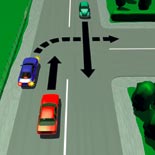 A. quickly turn right just before an oncoming car arrivesB. signal right for three seconds and turn right when it is safe to do soC. signal right for three seconds and then move into the centre of the road and wait thereD. take your chances and turn quickly before a car comes behind you.
A. quickly turn right just before an oncoming car arrivesB. signal right for three seconds and turn right when it is safe to do soC. signal right for three seconds and then move into the centre of the road and wait thereD. take your chances and turn quickly before a car comes behind you.
Explanation : When vehicles are moving fast or closely, it may be best to wait on the left-hand side of the road, turning after checking to see it is safe and indicating
# 65. When traffic is merging, what is a good rule to follow?
A. Slow down to 40 km/h.B. Speed up to make room behind.C. Let 1 vehicle in and then go.D. Let 2 vehicles in and go.
Explanation : As you merge, let one vehicle from the other lane go first, and then go.
# 66. You are driving past a line of parked cars. You notice a ball bouncing out into the road ahead. Do you:
A. keep driving at the same speed?B. keep driving at the same speed and flash the vehicle's headlights?C. slow down and be prepared to stop for children?D. slow down and move to the right-hand side of the road?
Explanation : there might be people behind the ball which you did not see yet
# 67. If you are driving at night with your vehicle headlights on high beam, you MUST dip them when coming up to:
A. an intersection.B. a one-way street.C. a police officer on point duty.D. a town or city.
Explanation : You must dip your vehicle's headlights: when other vehicles are coming towards you; and when you are following other vehicles; and when a police officer is directing traffic; and when you park.
# 68. Before going over a railway level crossing, you must:
A. stop under all circumstances.B. drive over only if there is space for your vehicle on the other side of the line.C. increase your speed so that you can cross the line as quickly as possible.D. sound the horn on your vehicle to warn other road users of your presence.
Explanation : cross only if you are sure there are no trains coming in either direction and there are no vehicles stopped in front of you on the other side of the crossing.
# 69. If you have to drive at a slow speed which may hold up other vehicles, what should you do?
A. Keep as close as you can to the centre of the road.B. Keep as close to the left-hand side of the road as you canC. Make the traffic behind you slow down to the speed that you are driving at.D. Drive down the middle of the road so that any vehicles behind you can pass on the left.
Explanation : You must keep as close to the left hand side of the road as possible this allows other cars to pass by safely
# 70. This sign means that:
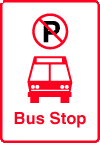 A. you may stop your vehicle if there are no buses coming.B. you may stop your vehicle between 6 pm and 8 pm except on Fridays and Saturdays.C. you may stop your vehicle if someone stays with it.D. you may not stop your vehicle at any time.
A. you may stop your vehicle if there are no buses coming.B. you may stop your vehicle between 6 pm and 8 pm except on Fridays and Saturdays.C. you may stop your vehicle if someone stays with it.D. you may not stop your vehicle at any time.
Explanation : You may not stop here at any time. Only buses can stop here
# 71. What is the best way to check for hazards before reversing your vehicle?
A. Relying only on the outside mirrors.B. Turning to look over your shoulders.C. Relying only on the inside mirrors.D. Walking around the vehicle before reversing.
Explanation : When reversing, take special care to make sure that the way is clear. If you are in any doubt about whether the way behind you is clear, get out and check.
# 72. You are driving on a country road at night when your vehicle headlights suddenly go out. What is the safest thing to do?
A. Carry on driving to the nearest garage with your vehicle hazard lights on.B. Slow down and drive on the far left side of the road.C. Carry on driving to the nearest garage with your vehicle's interior lights on.D. Slow down, move off the road gradually, stop and turn your vehicle hazard lights on.
Explanation : It is uncommon for both headlights to fail while you are driving, but it can happen. If your headlights do fail while you are driving, you should: slow down; move off the road gradually and stop somewhere safe; turn your hazard lights on.
# 73. If you are towing a vehicle or trailer, the distance between your vehicle and the one being towed must not be more than:
A. 2 metres.B. 4 metres.C. the length of the vehicle you are driving.D. the length of the vehicle being towed.
Explanation : There must be no more than four metres between your vehicle and the trailer or vehicle it is towing.
# 74. Flush medians can be used when you are:
A. passing other vehicles.B. stopping at traffic signals.C. waiting to turn right.D. parking for 5 minutes only.
Explanation : You can only drive onto the flush median to: wait to move into a gap in the traffic flow after you have turned right; slow down and wait before turning right.
# 75. When following a vehicle on a dusty metal (gravel) road, you should:
A. keep close to the other vehicles.B. drive down the centre of the road.C. adjust your speed to suit the conditions.D. pass the vehicle in front of you.
Explanation : Because gravel can move under your wheels, it offers very low skid resistance. Loose stones may also be thrown up by vehicles. Because of this you need to drive very carefully on gravel roads. Adjust your speed to suit the conditions.
# 76. When driving into bright sunlight, you should use sun glasses and your vehicle sun visors for safety. You are also advised to:
A. turn on the headlights of your vehicle.B. drive safely on the far left side of the road.C. look at and drive close to the centre of the road.D. pull over or stop and wait for a few minutes.
Explanation : pulling over and waiting for a few minutes would allow you to regain sight if blinded by the sunlight.
# 77. When driving into bright sunlight, you should use sunglasses and your vehicle sun visors for safety. You are also advised to:
A. turn the headlights of your vehicle on.B. drive safely on the far left of the road.C. look at and drive close to the centre of the road.D. pull over or stop and wait for a few minutes.
Explanation : Reducing the danger of sunstrike : Wear sunglasses when driving with the sun in your eyes; Use your car's sun visors to block the sun; If you experience sunstrike, it may be best to pull over and wait for a few minutes until your eyes adjust or visibility
# 78. On a motorway, what should you do if you are towing a trailer at the back of your car?
A. Turn on your hazard lightsB. Give hazard horns to warn other driversC. Take the left laneD. Take the center or right lane
Explanation : The maximum speed for a light vehicle towing a trailer on the open road is 90 km/h. you should use the left lane so as not to hold up traffics behind you.
# 79. What should you do when you are coming up to traffic signals and the signals change from green to yellow?
A. Stop at the signals if you can do so safely.B. Speed up before the light changes to red.C. Stop even if it means stopping in the middle of the intersection.D. Turn hard to the left and stop around the corner.
Explanation : A yellow signal means stop, unless you are so close to the intersection that you can't stop safely. A yellow signal indicates that the lights will soon turn red.
# 80. When must you always dip your vehicle headlights?
A. In a tunnel.B. On a motorway.C. When following other vehicles.D. When coming up to a railway level crossing.
Explanation : You must dip your vehicle's headlights: when other vehicles are coming towards you, so that you don't blind the oncoming driver; when you are following other vehicles; when a police officer is directing traffic; when you park.
# 81. You are driving at night and see a vehicle coming towards you with its headlights on high beam. Where should you look?
A. At the vehicle coming towards you.B. At the centre of the road.C. At the left side of the road.D. At the far right of the road.
Explanation : if you are blinded by the lights of oncoming vehicles: slow down or stop; try to keep your eyes on the left side of the road, so you aren't looking directly at the light












